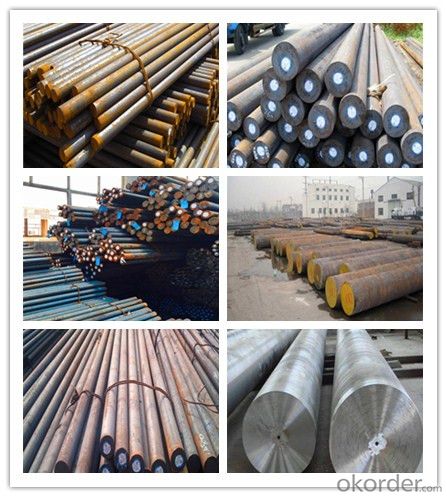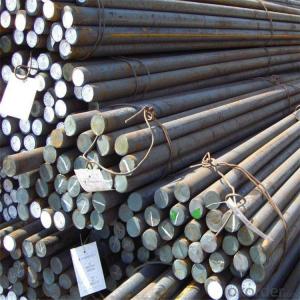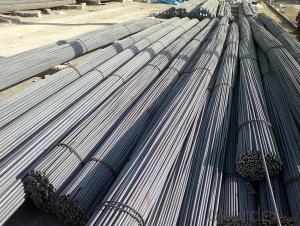Round Bars Carbon Steel SAE1020 AISI1020 S20C C22 S20CB
- Loading Port:
- Tianjin
- Payment Terms:
- TT OR LC
- Min Order Qty:
- 25 m.t.
- Supply Capability:
- 500000 m.t./month
OKorder Service Pledge
OKorder Financial Service
You Might Also Like
Item specifice
Round Bars Carbon Steel SAE1020 AISI1020 S20C C22 S20CB
Product Description of Round Bars Carbon Steel SAE1020 AISI1020 S20C C22
1. Steel grade: SAE1020, 20#, C22, S20C
2. Length: 6M-12M
3. Diameter: 16mm-300mm
4. Product range: round bar, flat bar, square bar
5. Technique: Hot rolled, forged, cold drawn
Specification of Round Bars Carbon Steel SAE1020 AISI1020 S20C C22 S20
Material | SAE 1020 | Round bar | Dia(mm) | 16-300mm |
Process | EAF + LF + VD + Forged + Heat Treatment (optional) | Length (mm) | Max 12m | |
Heat treatment | Normalized / Annealed / Quenched / tempered | Flat bar | Thickness(mm) | 8-500mm |
Delivery condition | Hot forged +Rough machined (black surface after Q/T)+ Turned (optional) | Width(mm) | 70-200mm | |
Test | Ultrasonic test according to SEP 1921-84 D/d | Length (mm) | Max 12m |
Chemical Composition of Round Bars Carbon Steel SAE1020 AISI1020 S20C C22
C | Si | Mn | Cr | Ni | Cu |
0.17~0.23 | 0.17~0.37 | 0.35~0.65 | ≤0.25 | ≤0.30 | ≤0.25 |
Photo Show of Round Bars Carbon Steel SAE1020 AISI1020 S20C C22

Packing and Delivery:
Packing in bundle package, or as customer's requirements.
Delivery Detail: 45 days after receiving the deposit.
Usage and Applications of Round Bars Carbon Steel SAE1020 AISI1020 S20C C22
1. Steel round bar is used in a large number of architectural and engineering structures. Or it can be used in construction of plants for the production of steel house frames, high-voltage transmission towers, bridges, vehicles, boilers, containers, ships, etc.
2. And we can use this kind of product on the performance of the mechanical parts if the demand is not very high.
3. Some special material steel round bar can be used for main shaft of steamer, hummer shank, with big section and supper force.
Company Information
CNBM International Corporation is the most important trading platform of CNBM group.
Whith its advantages, CNBM International are mainly concentrate on Cement, Glass, Iron and Steel, Ceramics industries and devotes herself for supplying high qulity series of refractories as well as technical consultancies and logistics solutions.


F A Q
1, Your advantages?
professional products inquiry, products knowledge train (for agents), smooth goods delivery, excellent customer solution proposale
2, Test & Certificate?
SGS test is available, customer inspection before shipping is welcome, third party inspection is no problem
3, Factory or Trading Company?
CNBM is a trading company but we have so many protocol factories and CNBM works as a trading department of these factories. Also CNBM is the holding company of many factories.
4, Payment Terms?
30% TT as deposit and 70% before delivery.
Irrevocable L/C at sight.
5, Trading Terms?
EXW, FOB, CIF, FFR, CNF
6, After-sale Service?
CNBM provides the services and support you need for every step of our cooperation. We're the business partner you can trust.
For any problem, please kindly contact us at any your convenient time.
We'll reply you in our first priority within 24 hours.
- Q:What are the different surface defects that can occur in steel round bars?
- There are several different surface defects that can occur in steel round bars. These defects can be classified into various categories based on their appearance and severity. Some of the common surface defects include: 1. Scale: Scale is a thin layer of oxide that forms on the surface of steel during the manufacturing process. It appears as a rough, flaky coating and can be easily removed by mechanical means. 2. Pits: Pits are small depressions or craters that can occur on the surface of the steel. They are usually caused by corrosion or mechanical damage. Pits can weaken the structural integrity of the steel and may require repair or replacement. 3. Scratches: Scratches are shallow grooves or cuts on the surface of the steel. They can be caused by handling, transportation, or machining processes. While minor scratches may not affect the performance of the steel, deep scratches can lead to stress concentration and potential failure. 4. Roll marks: Roll marks are raised or depressed lines or patterns that are left on the surface of the steel during the rolling process. These marks are typically caused by the uneven pressure distribution between the rolls and can affect the dimensional accuracy and surface quality of the steel. 5. Laminations: Laminations are thin layers or bands of non-metallic inclusions that can occur parallel to the surface of the steel. They are usually caused by inadequate refining or improper casting techniques. Laminations can decrease the strength and toughness of the steel and may require further processing or rejection. 6. Decarburization: Decarburization refers to the loss of carbon content on the surface of the steel. It can occur during heating, annealing, or hot working processes. Decarburization can reduce the hardness and strength of the steel and may lead to premature failure under load. 7. Surface cracks: Surface cracks are visible cracks that occur on the surface of the steel. They can be caused by excessive cooling rates, improper heat treatment, or mechanical stress. Surface cracks can compromise the structural integrity of the steel and may require repairs or rejection. These are just a few examples of the different surface defects that can occur in steel round bars. It is essential to inspect and address these defects to ensure the quality and performance of the steel in various applications.
- Q:Are steel round bars prone to deformation?
- Steel round bars are generally not prone to deformation when they are properly manufactured and used within their intended limits. Steel is known for its high tensile strength and durability, making it resistant to bending or warping under normal circumstances. However, it is important to note that excessive force or improper handling can still cause deformation in steel round bars. Overloading, incorrect storage conditions, or inappropriate machining techniques can all contribute to bending or twisting of the bars. Therefore, it is crucial to follow recommended guidelines and industry standards to ensure the integrity and longevity of steel round bars.
- Q:Can steel round bars be heat treated to enhance their properties?
- Yes, steel round bars can be heat treated to enhance their properties. Heat treatment is a process of heating and cooling the steel in a controlled manner to alter its microstructure, which in turn improves its mechanical properties such as strength, hardness, toughness, and ductility. There are several heat treatment methods that can be applied to steel round bars, depending on the desired outcome. One common method is quenching and tempering. In this process, the steel is heated to a high temperature to form a uniform austenitic structure, and then rapidly cooled by quenching it in a medium such as oil or water. This rapid cooling transforms the austenite into a harder and stronger structure called martensite. However, martensite can be brittle, so the steel is then tempered by reheating it to a lower temperature, which reduces the brittleness and increases toughness while maintaining the desired hardness. Another heat treatment method is annealing, where the steel is heated to a specific temperature and then slowly cooled to relieve internal stresses and improve ductility. This process can also refine the grain structure of the steel, resulting in improved machinability and formability. In addition, there are other heat treatment methods such as normalizing, stress relieving, and case hardening, each designed to enhance specific properties of the steel round bars. Overall, heat treatment is a versatile and effective technique to enhance the properties of steel round bars, allowing them to meet specific requirements for various applications in industries such as manufacturing, construction, automotive, and aerospace.
- Q:What are the different types of steel round bars used in the automotive engine components?
- Automotive engine components rely on various types of steel round bars, each possessing unique properties and applications. 1. Carbon Steel Round Bars: The most prevalent variant, carbon steel round bars, display exceptional strength and durability. Their versatility allows them to be employed in manifold applications such as crankshafts, connecting rods, and camshafts. They excel in withstanding elevated stress levels and extreme temperatures. 2. Alloy Steel Round Bars: By introducing alloying elements like chromium, nickel, and molybdenum to carbon steel, alloy steel round bars enhance their strength, toughness, and resistance to wear. They find common usage in automotive engine components like gears, shafts, and bearings, which necessitate high strength and the ability to resist wear and fatigue. 3. Stainless Steel Round Bars: Automotive engine components that encounter corrosive fluids or environments benefit from the corrosion-resistant properties of stainless steel round bars. Valves, pistons, and exhaust systems are among the applications where stainless steel round bars are frequently employed. 4. Tool Steel Round Bars: Tool steel round bars are renowned for their remarkable hardness, abrasion resistance, and superior toughness. They are extensively utilized in automotive engine components involved in cutting or shaping processes, such as cutting tools, dies, and punches. 5. High-Speed Steel Round Bars: High-speed steel round bars are engineered to endure high temperatures while maintaining hardness and cutting efficiency at elevated speeds. Drills, milling cutters, and reamers in automotive engine components often benefit from high-speed steel round bars. It is crucial to highlight that the choice of steel round bar for automotive engine components depends on the specific application, performance requirements, and cost considerations. Automotive manufacturers meticulously select the appropriate steel grade to guarantee optimal performance and durability of engine components.
- Q:Are steel round bars suitable for use in the construction of bridges?
- Yes, steel round bars are suitable for use in the construction of bridges. Steel round bars offer several advantages that make them an ideal choice for bridge construction. Firstly, steel round bars have high tensile strength, which means they can withstand heavy loads and forces without deforming or breaking. This is crucial for bridges as they need to support the weight of vehicles and pedestrians crossing over them. The high tensile strength of steel round bars ensures the structural integrity and safety of the bridge. Additionally, steel round bars have excellent durability and corrosion resistance. Bridges are often exposed to harsh environmental conditions, such as rain, snow, and saltwater, which can lead to corrosion and degradation of materials. However, steel round bars are specifically designed to resist corrosion, ensuring the longevity and reliability of the bridge. Moreover, steel round bars are readily available in various sizes and lengths, making them versatile and adaptable for different bridge designs and configurations. Their uniform circular shape also simplifies the construction process, as they can be easily cut, bent, and welded to fit the required specifications. Furthermore, steel round bars offer cost-effectiveness in bridge construction. They have a favorable strength-to-weight ratio, meaning they can provide the necessary strength while minimizing the overall weight of the bridge. This reduces the amount of material needed and lowers transportation costs during construction. In conclusion, steel round bars are highly suitable for use in the construction of bridges due to their high tensile strength, durability, corrosion resistance, versatility, and cost-effectiveness. They provide the necessary strength and reliability to support heavy loads and withstand harsh environmental conditions, ensuring the safety and longevity of the bridge.
- Q:What are the different machining processes used for steel round bars?
- There are several machining processes commonly used for steel round bars, depending on the desired outcome and specifications of the project. Some of the most common machining processes for steel round bars include: 1. Turning: Turning is a machining process where the round bar is rotated and a cutting tool is used to remove material, creating a desired shape or size. This process is commonly used to reduce the diameter of the round bar or to create precision cylindrical shapes. 2. Drilling: Drilling involves creating holes in the steel round bar using a rotating cutting tool called a drill bit. This process is often used to create holes for bolts, screws, or other fasteners. 3. Milling: Milling is a machining process that involves removing material from the surface of the steel round bar using a rotating cutting tool with multiple teeth. This process is used to create flat surfaces, grooves, or complex shapes on the round bar. 4. Grinding: Grinding is a process where abrasive particles are used to remove material from the steel round bar, creating a smooth surface finish or achieving specific tolerances. It is commonly used to refine the surface finish or to remove any imperfections. 5. Thread rolling: Thread rolling is a process used to create external threads on the steel round bar. A hardened steel die is pressed against the rotating round bar, causing the material to flow and form the desired threads. 6. Cold drawing: Cold drawing is a process where the steel round bar is pulled through a die to reduce its diameter and improve its surface finish. This process is used to create precise dimensions and improve the mechanical properties of the steel round bar. 7. Heat treatment: Heat treatment is not a machining process itself, but it is often used in conjunction with machining to enhance the properties of the steel round bar. Heat treatment processes such as annealing, quenching, and tempering can be used to improve hardness, strength, and toughness. These are just a few of the many machining processes that can be used for steel round bars. The specific process chosen will depend on factors such as the desired shape, size, surface finish, and mechanical properties required for the application.
- Q:How are steel round bars used in the construction of transmission towers?
- Steel round bars are commonly used in the construction of transmission towers due to their strength, durability, and ease of fabrication. These bars are typically made from high-strength carbon steel and are available in various diameters to suit different structural requirements. In the construction of transmission towers, steel round bars are primarily used as the main structural elements. They form the vertical and diagonal members that provide strength and stability to the tower. The bars are typically connected together using various methods like welding or bolted connections to form the lattice structure of the tower. The round shape of the bars allows for uniform distribution of forces, making them ideal for withstanding the loads and stresses that transmission towers experience. These loads include the weight of the tower itself, the electrical conductors, and environmental factors like wind, ice, and seismic forces. Additionally, steel round bars offer excellent corrosion resistance, which is crucial for transmission towers that are often exposed to harsh weather conditions. This resistance helps to prolong the lifespan of the tower and ensures the safety and reliability of the transmission lines. Furthermore, steel round bars can be easily fabricated and customized according to the specific design requirements of the transmission tower. They can be cut, bent, and shaped into the desired dimensions, allowing for flexibility in tower design and construction. Overall, steel round bars play a vital role in the construction of transmission towers by providing strength, durability, and resistance to corrosion. Their versatility and ability to withstand various loads make them an essential component in ensuring the safe and reliable transmission of electricity.
- Q:Can steel round bars be used in the chemical industry?
- Yes, steel round bars can be used in the chemical industry. Steel is often preferred in the chemical industry due to its high strength and durability. Steel round bars are commonly used for construction of storage tanks, pipelines, and equipment in chemical plants. The material's resistance to corrosion makes it suitable for handling various types of chemicals, acids, and alkalis. Steel round bars also provide excellent structural support, which is crucial in maintaining the integrity and safety of chemical processes. Overall, steel round bars are a reliable and widely used material in the chemical industry.
- Q:How can I connect channel steel and round steel?
- The connection of channel steel and round steel is done by welding, and the strength of the screw connection is not enough.
- Q:Use of stainless steel round bar
- Stainless steel round bar is a kind of long material, and it is also a kind of bar. The so-called stainless steel round bar refers to the cross section is even round long material, generally about four meters long. It can be divided into light and black. The so-called light circle, refers to the smooth surface after processing and quasi rolling; and the so-called, refers to the surface of the black, coarse, and direct rolling.
1. Manufacturer Overview |
|
|---|---|
| Location | |
| Year Established | |
| Annual Output Value | |
| Main Markets | |
| Company Certifications | |
2. Manufacturer Certificates |
|
|---|---|
| a) Certification Name | |
| Range | |
| Reference | |
| Validity Period | |
3. Manufacturer Capability |
|
|---|---|
| a)Trade Capacity | |
| Nearest Port | |
| Export Percentage | |
| No.of Employees in Trade Department | |
| Language Spoken: | |
| b)Factory Information | |
| Factory Size: | |
| No. of Production Lines | |
| Contract Manufacturing | |
| Product Price Range | |
Send your message to us
Round Bars Carbon Steel SAE1020 AISI1020 S20C C22 S20CB
- Loading Port:
- Tianjin
- Payment Terms:
- TT OR LC
- Min Order Qty:
- 25 m.t.
- Supply Capability:
- 500000 m.t./month
OKorder Service Pledge
OKorder Financial Service
Similar products
New products
Hot products
Related keywords


































